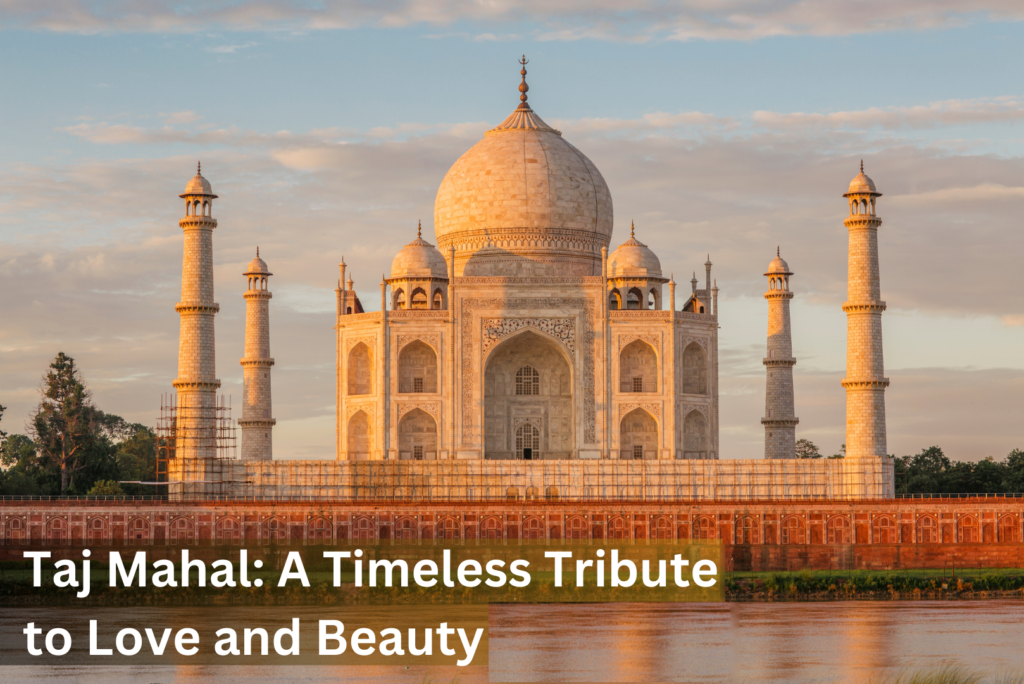
Taj Mahal: A Timeless Tribute to Love and Beauty
The Taj Mahal stands as an ethereal testament to love, beauty, and architectural brilliance, captivating millions with its timeless elegance. Commissioned by the Mughal Emperor Shah Jahan, it was built in memory of his beloved wife Mumtaz Mahal, who tragically passed away during childbirth. Construction began in 1632 and was completed in 1653, with artisans and craftsmen from across the empire contributing to its exquisite design and intricate details.
Located on the southern bank of the Yamuna River in Agra, India, the Taj Mahal sits amidst lush gardens, reflecting pools, and serene surroundings. Its pristine white marble facade, adorned with delicate carvings and intricate inlays of semi-precious stones, exudes a sense of ethereal beauty and serenity.
As one approaches the mausoleum through the imposing main gateway, known as the Darwaza-i Rauza, the grandeur of the Taj Mahal becomes increasingly apparent, beckoning visitors to step into its hallowed halls.
Each year, upwards of 7 million visitors from around the world make a pilgrimage to the Taj Mahal, drawn by its captivating allure and timeless romance. It is estimated that over 7-8 million people visit the monument annually, making it one of the most visited landmarks in the world. Whether they come to admire its architectural splendor, pay homage to a timeless love story, or simply soak in the tranquility of its surroundings, the Taj Mahal never fails to leave a lasting impression on all who behold it.
At the heart of the Taj Mahal complex lies the majestic mausoleum itself, a symphony of marble and precious stones that houses the tombs of Shah Jahan and Mumtaz Mahal. The central dome, towering gracefully above the structure, is adorned with intricate calligraphy and geometric patterns, while the four minarets that flank the main structure add to its majestic grandeur.
Inside the mausoleum, the tombs of Shah Jahan and Mumtaz Mahal are enclosed in a chamber adorned with intricate marble screens and exquisite floral motifs, creating an atmosphere of sublime beauty and reverence. Surrounding the mausoleum are lush gardens, laid out in a classic Mughal Charbagh style, with pathways and water channels symbolizing the four rivers of Paradise.
The reflecting pool in front of the Taj Mahal offers mesmerizing views of the monument, with its pristine white marble facade mirrored in the tranquil waters.
As visitors wander through the gardens, they are treated to breathtaking vistas of the Taj Mahal from different angles, each offering a unique perspective on this architectural masterpiece.
In addition to the mausoleum and gardens, the Taj Mahal complex also includes several other notable structures, such as the Great Gate, the mosque, and the guesthouse.
These architectural elements contribute to the overall harmony and balance of the complex, enhancing its aesthetic appeal and cultural significance.
As the sun sets over the Yamuna River, casting a golden glow on the Taj Mahal, visitors are filled with a sense of awe and wonder at the beauty and majesty of this timeless monument. For centuries, it has stood as a symbol of enduring love and architectural brilliance, captivating hearts and minds with its timeless allure.
Indeed, the Taj Mahal remains an enduring testament to the power of love, beauty, and human creativity, inspiring generations to come.
AFFILIATE LINK: If you’re planning a trip to the Taj Mahal, click this link to read about one of the most popular tours offered there: Taj Mahal with Mausoleum Skip-the-Line tickets & guide